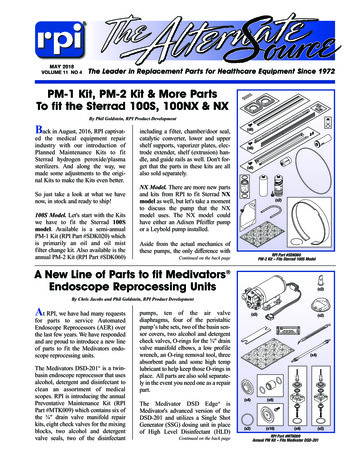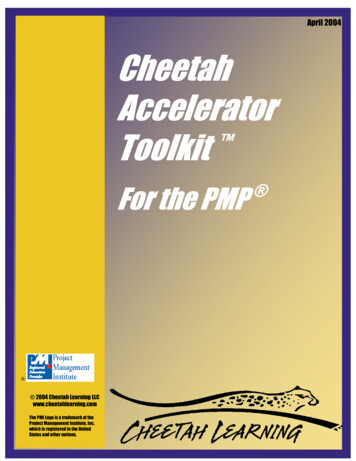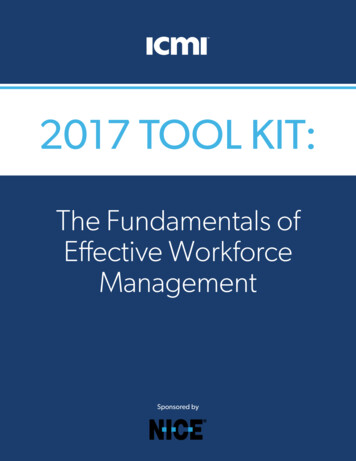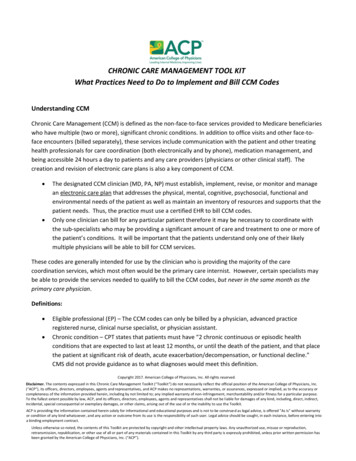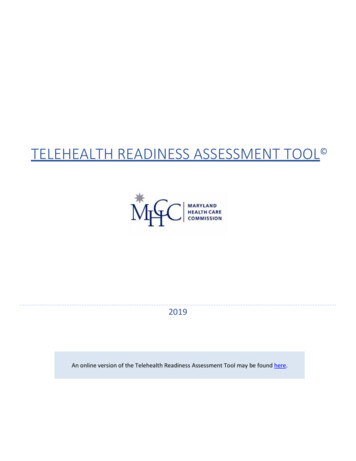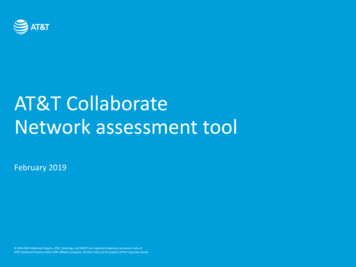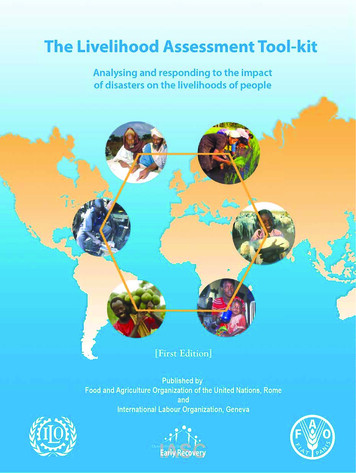
Transcription
The Livelihood Assessment Tool-kitAnalysing and responding to the impact of disasterson the livelihoods of people[First Edition]Published byFood and Agriculture Organizationof the United Nations (FAO), RomeandInternational Labour Organization (ILO), GenevaApril 2009
First published 2009The designations employed and the presentation of material in this publication do not imply the expressionof any opinion whatsoever on the part of the Food and Agriculture Organization of the United Nations (FAO) or of theInternational Labour Organization (ILO) concerning the legal or development status of any country, territory, city or areaor of its authorities, or concerning the delimitation of its frontiers or boundaries. The mention of specific companies orproducts of manufacturers, whether or not these have been patented, does not imply that these have been endorsed orrecommended by FAO or ILO in preference to others of a similar nature that are not mentioned. The views expressedherein are those of the authors and do not necessarily represent those of FAO or ILO.ISBN 978-92-5-106230-2All rights reserved. Reproduction and dissemination of material in this information product for educational orother non-commercial purposes are authorized without any prior written permission from the copyright holdersprovided the source is fully acknowledged. Reproduction of material in this information product for resale or othercommercial purposes is prohibited without written permission of the copyright holders. Applications for suchpermission should be addressed to: Chief, Electronic Publishing Policy and Support Branch, Communication Division,FAO, Viale delle Terme di Caracalla, 00153 Rome, Italy or by email to: copyright@fao.org FAO and ILO, 2009
TA B L E O F C O N T E N T SAcronyms and Abbreviations.ivPreface.vVolume 1:Methodological and Conceptual Overview. 1Volume 2:Livelihood Baseline and Contingency Plan. 17Volume 3:Initial Livelihood Impact Appraisal. 67Volume 4:Detailed Livelihood Assessment.115iii
A c r on y m s an d abb r e v i at i onsAEZAgro-ecological ZonesCBOCommunity-based OrganizationCSOCentral Statistics OfficeDLADetailed Livelihood AssessmentDSADaily Subsistence AllowanceFAOFood and Agriculture Organization of the United NationsFEWSNET Famine Early Warning System NetworkGISGeographic Information SystemsIDPInternally displaced personIFIInternational Funding InstitutionsILIAInitial Livelihood Impact AppraisalILOInternational Labour OrganizationLATLivelihood Assessment Tool-kitLBLivelihood BaselineLFSLabour Force SurveysNGONon-governmental organizationOCHAOffice for the Coordination of Humanitarian AffairsPDNAPost-Disaster Needs AssessmentPRAParticipatory Rapid Assessment / AppraisalSLFSustainable Livelihoods FrameworkSSISemi-structured InterviewingTLTeam LeaderUNUnited NationsUNDACUnited Nations Disaster Assessment and CoordinationUNDPUnited Nations Development ProgrammeUNIDOUnited Nations Industrial Development OrganizationUNOSATUnited Nations consortium created to provide enhanced accessto satellite imagery and geographic information systemsWFPWorld Food Programmeiv
P R E FA C EIn 2007 a total of 414 natural disasters were reported, spread over some115 countries, killing 16 847 people, affecting more than 211 million othersand causing economic damages amounting to USD 75 billion. This is part of atrend of rising disaster frequency, and in this context, protecting and rebuildingthe livelihoods of those vulnerable to disasters becomes an urgent priority.Assessing the impact of disasters on the livelihoods of people and the capacityand opportunities for recovery and increased resilience to future events is animportant part of the response to disasters, yet current assessment systemsare often weak, uncoordinated and are not strongly linked to livelihoodrecovery interventions. In order to improve understanding of the impactof disasters on livelihoods, the Food and Agriculture Organization of the UnitedNations (FAO) and the International Labour Organization (ILO) have jointlydeveloped the Livelihood Assessment Tool-kit (LAT). The LAT consists of threemain technical elements: Livelihood Baseline Assessment (which is undertakenpre-disaster); Immediate Livelihood Impact Appraisal (undertaken immediatelyafter the disaster); and Detailed Livelihood Assessment (undertaken up to 90days after the disaster).In the process of development, the LAT has been tested, redefined and refinedin a number of countries including Pakistan (2005 Kashmir earthquake);Indonesia (2006 volcanic eruption and earthquake in Yogjakarta); Philippines(2006 Typhoon Reming); Bolivia (2007 flooding); and Pakistan again in 2008(livelihood baseline work). This process of continual learning and improvementcontinues, and so the current set of guidelines contained in these volumesshould be seen as one stage in the development of the approach.In this spirit, suggestions for improvement are welcomedand should be directed to:TCE-LAT@fao.org and cruciani@ilo.orgFAO, Rome and ILO, GenevaApril 2009
VOLU M E 1Methodological and Conceptual Overview
The Livelihood Assessment Tool-kitAnalysing and responding to the impact of disasterson the livelihoods of peopleVolume 1:Methodological and Conceptual Overview[First Edition]Published byFood and Agriculture Organizationof the United Nations (FAO), RomeandInternational Labour Organization (ILO), Geneva
M e t h o d o l o g i c a la n dC o n c e p t u a lO v e r v i e wTable of C ontentsOverview of the Livelihood Assessment Tool-kit for Sudden Onset Disasters. 5Assessment Preparedness. 8Sustainable Livelihood Approach and the LAT. 10Livelihood assets. 11Vulnerability and coping strategies. 13The institutional context. 14Livelihood strategies and outcomes. 15
M e t h o d o l o g i c a la n dC o n c e p t u a lO v e r v i e wOverview of the Livelihood Assessment Tool-kit for SuddenOnset Natural DisastersThe Livelihood Assessment Tool-kit (LAT) process consists of three interrelated elements: a Livelihood Baseline (LB); an Initial Livelihood ImpactAppraisal (ILIA); and a Detailed Livelihood Assessment (DLA). As currentlydesigned, the LAT is aimed at sudden onset natural disasters. However, it isplanned to extend the coverage of the LAT to other types of emergency.Each of the three parts of the LAT serves different but related functions inthe assessment process. Each part may also have different targets in terms offunding mechanisms and may be executed by different people, as indicated inthe following table.ElementFunctionProgramming/funding targetLB LivelihoodBaselineTo provide a good pictureof ‘normal’ livelihoodpatterns in areas at riskfrom natural hazardstogether with an indicationof likely impact of hazards,key response prioritiesand institutions likely to beinvolved in recovery.It is useful to elaboratequick briefs for flashappeal, early recoverydonor conferenceand information to thepublic. Could be used toextrapolate from, if ILIA isnot possible before FlashAppeals.Gives a ‘head start’ forpost-disaster assessments.Provides the pre-disastercontext for the ILIA andDLA, so enhancingthe power of thesetools to make informedgeneralizations on thelivelihood impact andopportunities presented bythe disaster.When and by whom?When? Time takento compile baseline:Heavily dependent onsize and complexity ofhazard prone areas.In Pakistan, districtlevel baselines take2-3 weeks each.Compilation done beforethe disaster.By whom? Ideally,multi-agency teamsdrawn from UN,governments, NGOs.cont./
M e t h o d o l o g i c a lILIA InitialLivelihoodImpactAppraisalDLA DetailedLivelihoodAssessmenta n dC o n c e p t u a lO v e r v i e wInitial assessment ofimpact of disaster onlivelihoods at ‘local level’– to be integrated intomulti-sectoral quickimpact assessments andfeeding into Flash Appealproposals.ILIA provides immediatefirst hand information onthe impact of the disasteron the livelihoods of theaffected people. This infois to be combined with thebaseline, thus giving asolid basis to the proposalsfor immediate action onlivelihood recovery thatwill feed the first FlashAppeals, early recoverydonor conference andsubsequent livelihoodsprogrammes.When? Duration ofassessment: 1 – 7days. Usual window forassessment: Withinfirst 10 days af terdisaster.Assessment of impact ofdisaster on livelihoods andopportunities, capacitiesand needs for recoveryat household, community,and local economy levels.Includes conversion of theresults of assessmentsinto response optionscontaining strategy outlinesprogramme profiles andconcrete projects.Provides a moredetailed information andrationale for strategies,programmes and projectsto be submitted toRevised Flash appealand / or Early Recoverydonor conference, forfunding purposes, and / ordevelopment of LivelihoodRecovery Strategies.When? Duration ofassessment: 30 days.Usual window forassessment: Within 90days of the disaster.By whom? Ideallynational governmentand UN staff /consultants integratedinto the United NationsDisaster Assessmentand Coordination(UNDAC) team.By whom? Multidisciplinary, multi– agency teams(including Nationalgovernment staff) led bylivelihood specialists.The LAT approach has several important features, including the following: Strong linkages between tools: The three assessment stages of the LAT areclosely linked in the sense that they support and feed into one another. Thusthe baseline sets the pre-disaster context and defines certain questions andrelationships for the post-disaster ILIA and the DLA. The ILIA will providea general picture which will be refined and developed by the DLA, and theDLA itself will help re-define the baseline.
M e t h o d o l o g i c a la n dC o n c e p t u a lO v e r v i e w Quantitative and qualitative: A key function of the baseline is to providea context within which the findings of the more qualitative and areaspecific ILIA and DLA can be interpreted. Combining a more quantitative,generalized baseline picture with the ILIA and particularly the DLA meansthat we can derive prevalence, gauge severity and trace processes in a waywhich is not possible when either quantitative or qualitative methods areused alone. Livelihood opportunities and capacities, as well as impact: In additionto looking at the impact of a disaster on people and their current copingstrategies, the LAT approach actively identifies capacities and opportunitiesfor recovery and increased resilience. This means that it goes further thanmost assessment methods. Tailored to funding and programming mechanisms: The assessmentmethods and stages are specifically tailored to key funding and programmingmechanisms. The ILIA, building on and utilizing the baseline is tailored tothe Flash Appeal, whereas the DLA, again combined with interpretationof the baseline, is aimed at a revised flash appeal and / or an early recoverydonor conference. The DLA is also intended to serve as the basis for moredetailed project and programme formulation missions leading into a numberof programming avenues including government livelihood recovery strategiesand agency specific projects and programmes. A modular approach: Whilst the three assessment tools are related andare utilized to most powerful effect when used as a “package” they can alsobe used independently. This has been done in recognition of the fact thatit may not always be possible to have a full suite of elements in each givenemergency situation. Thus, a DLA may be carried out even if no prior baselineinformation is available or no ILIA has been carried out immediately afterthe onset of the disaster. Likewise, a successful ILIA does not depend on anex-ante LB (although it would benefit from one).
M e t h o d o l o g i c a la n dC o n c e p t u a lO v e r v i e wAssessment preparednessIn order to be most effective, the LAT should be integrated as much as possibleinto country level disaster preparedness systems and structures and supportedby global level capacities where relevant. The key elements of assessmentpreparedness can be summarized as follows:Partnerships: The LAT cannot proceed effectively without the activesupport and participation of government and development partners.Furthermore, the results of LAT assessments have to be communicated intimely and effective manner to government and donors through appropriatemechanisms and fora. This requires training and accordingly an LATtraining package is under development. In general, the buy in and supportof government, donors and partners at country level needs to be assuredthrough dialogue, mutual learning, training and sensitization.Development of expert rosters: development of rosters of national, regional,and headquarter level experts from FAO, ILO and other organizations andconsultants. This is key to ensure that assessment
In this spirit, suggestions for improvement are welcomed and should be directed to: TCE-LAT@fao.org and cruciani@ilo.org FAO, Rome and ILO, Geneva April 2009. VOLUME 1 Methodological and Conceptual Overview. The Livelihood Assessment Tool-kit Analysing and responding to the impact of disasters on the livelihoods of people volume 1: methodological and Conceptual Overview [First

